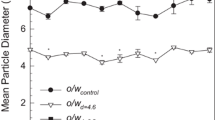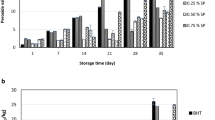Abstract
Gelled emulsions with carrageenan are a novel type of emulsion that could be used as a carrier of unsaturated fatty acids in functional foods formulations. Lipid degradation through volatile compounds was studied in gelled emulsions which were high in polyunsaturated oils (sunflower or algae oil) after 49 days of storage. Aqueous Lavandula latifolia extract was tested as a natural antioxidant. Analysis of the complete volatile profile of the samples resulted in a total of 40 compounds, classified in alkanes, alkenes, aldehydes, ketones, acids, alcohols, furans, terpenes and aromatic hydrocarbons. During storage, the formation of the volatile compounds was mostly related to the oxidation of the main fatty acids of the sunflower oil (linolenic acid) and the algae oil (docosahexaenoic acid). Despite the antioxidant capacity shown by the L. latifolia extract, its influence in the oxidative stability in terms of total volatiles was only noticed in sunflower oil gels (p < 0.05), where a significant decrease in the aldehydes fraction was found.

Similar content being viewed by others
References
AOAC (2002) Methyl esters of fatty acids in oils and fats. 969.33. Official methods of analysis. Association of Official Analytical Chemists, Gaithersburg, pp 19–20
Barriuso B, Astiasarán I, Ansorena D (2013) A review of analytical methods measuring lipid oxidation status in foods: a challenging task. Eur Food Res Technol 236:1–15
Cao J, Deng L, Zhu X, Fan Y, Hu J, Li J, Deng Z (2014) Novel approach to evaluate the oxidation state of vegetable oils using characteristic oxidation indicators. J Agric Food Chem 62:12545–12552
Chen H, Lin Y, Hsieh C (2007) Evaluation of antioxidant activity of aqueous extract of some selected nutraceutical herbs. Food Chem 104:1418–1424
Cofrades S, Santos-López JA, Freire M, Benedí J, Sánchez-Muniz FJ, Jiménez-Colmenero E (2014) Oxidative stability of meat systems made with W-1/O/W-2 emulsions prepared with hydroxytyrosol and chia oil as lipid phase. Lwt- Food Sci Technol 59:941–947
Costa P, Goncalves S, Valentao P, Andrade PB, Romano A (2013) Accumulation of phenolic compounds in in vitro cultures and wild plants of Lavandula viridis L’Her and their antioxidant and anti-cholinesterase potential. Food Chem Toxicol 57:69–74
Farvin KHS, Grejsen HD, Jacobsen C (2012) Potato peel extract as a natural antioxidant in chilled storage of minced horse mackerel (Trachurus trachurus): effect on lipid and protein oxidation. Food Chem 131:843–851
Frankel EN, Satué-Gracia T, Meyer AS, German JB (2002) Oxidative stability of fish and algae oils containing long-chain polyunsaturated fatty acids in bulk and in oil-in-water emulsions. J Agric Food Chem 50:2094–2099
Gallego GM, Gordon MH, Segovia FJ, Skowyra M, Almajano MP (2013) Antioxidant properties of three aromatic herbs (Rosemary, Thyme and Lavender) in oil-in-water emulsions. J Am Oil Chem Soc 90:1559–1568
García-Herreros C, García-Iñiguez M, Astiasarán I, Ansorena D (2010) Antioxidant activity and phenolic content of water extracts of Borago Officinalis L.: influence of plant part and cooking procedure. Ital J Food Sci 22:156–164
García-Iñiguez de Ciriano M, García-Herreros C, Larequi E, Valencia I, Ansorena D, Astiasarán I (2009) Use of natural antioxidants from lyophilized water extracts of Borago officinalis in dry fermented sausages enriched in omega-3 PUFA. Meat Sci 83:271–277
García-Iñiguez de Ciriano M, Rehecho S, Isabel Calvo M, Yolanda Cavero R, Navarro I, Astiasaran I, Ansorena D (2010) Effect of lyophilized water extracts of Melissa officinalis on the stability of algae and linseed oil-in-water emulsion to be used as a functional ingredient in meat products. Meat Sci 85:373–377
Giogios I, Grigorakis K, Nengas I, Papasolomontos S, Papaioannou N, Alexis MN (2009) Fatty acid composition and volatile compounds of selected marine oils and meals. J Sci Food Agric 89:88–100
Goicoechea E, Guillén MD (2014) Volatile compounds generated in corn oil stored at room temperature. Presence of toxic compounds. Eur J Lipid SciTechnol 116:395–406
Gómez-Cortés P, Sacks GL, Brenna JT (2015) Quantitative analysis of volatiles in edible oils following accelerated oxidation using broad spectrum isotope standards. Food Chem 174:310–318
Guillén MD, Goicoechea E (2008) Formation of oxygenated alpha, beta-unsaturated aldehydes and other toxic compounds in sunflower oil oxidation at room temperature in closed receptacles. Food Chem 111:157–164
Guillén MD, Carton I, Salmeron J, Casas C (2009) Headspace composition of cod liver oil and its evolution in storage after opening. First evidence of the presence of toxic aldehydes. Food Chem 114:1291–1300
Herraiz-Peñalver D, Angeles Cases M, Varela F, Navarrete P, Sanchez-Vioque R, Usano-Alemany J (2013) Chemical characterization of Lavandula latifolia Medik. essential oil from Spanish wild populations. Biochem Syst Ecol 46:59–68
Hsu C, Chang C, Lu H, Chung Y (2007) Inhibitory effects of the water extracts of Lavendula sp on mushroom tyrosinase activity. Food Chem 105:1099–1105
Kerrihard AL, Pegg RB, Sarkar A, Craft BD (2015) Update on the methods for monitoring UFA oxidation in food products. Eur J Lipid Sci Technol 117:1–14
Kondjoyan N, Berdagué JL (1996) A compilation of relative retention indices for the analysis of aromatic compounds. Laboratoire Flaveur, France
Lee H, Kizito SA, Weese SJ, Craig-Schmidt MC, Lee Y, Wei CI, An H (2003) Analysis of headspace volatile and oxidized volatile compounds in DHA-enriched fish oil on accelerated oxidative storage. J Food Sci 68:2169–2177
López V, Akerreta S, Casanova E, García-Mina JM, Cavero RY, Calvo MI (2007) In vitro antioxidant and anti-rhizopus activities of lamiaceae herbal extracts. Plant Foods Hum Nutr 62:151–155
McClements DJ (2010) Emulsion design to improve the delivery of functional lipophilic components. Annu Rev Food Sci Technol 1:241–269
Moure A, Cruz JM, Franco D, Domínguez JM, Sineiro J, Domínguez H, Nuñez MJ, Parajó JC (2001) Natural antioxidants from residual sources. Food Chem 72:145–171
O’Dwyer SP, O’Beirne D, Eidhin DN, O’Kennedy BT (2013) Effects of emulsification and microencapsulation on the oxidative stability of camelina and sunflower oils. J Microencapsul 30:451–459
Paradiso VM, Giarnetti M, Summo C, Pasqualone A, Minervini F, Caponio F (2015) Production and characterization of emulsion filled gels based on inulin and extra virgin olive oil. Food Hydrocoll 45:30–40
Poyato C, Navarro-Blasco I, Calvo MI, Cavero RY, Astiasarán I, Ansorena D (2013) Oxidative stability of O/W and W/O/W emulsions: effect of lipid composition and antioxidant polarity. Food Res Int 51:132–140
Poyato C, Ansorena D, Berasategi I, Navarro-Blasco Í, Astiasarán I (2014a) Optimization of a gelled emulsion intended to supply ω-3 fatty acids into meat products by means of response surface methodology. Meat Sci 98:615–621
Poyato C, Ansorena D, Navarro-Blasco I, Astiasarán I (2014b) A novel approach to monitor the oxidation process of different types of heated oils by using chemometric tools. Food Res Int 57:152–161
Ritter JCS, Budge SM (2012) Key lipid oxidation products can be used to predict sensory quality of fish oils with different levels of EPA and DHA. Lipids 47:1169–1179
Ross CF, Smith DM (2006) Use of volatiles as indicators of lipid oxidation in muscle foods. CRev Food Sci Food Saf 5:18–25
Ryckebosch E, Bruneel C, Termote-Verhalle R, Lemahieu C, Muylaert K, Van Durme J, Goiris K, Foubert I (2013) Stability of Omega-3 LC-PUFA-rich photoautotrophic microalgal oils compared to commercially available Omega-3 LC-PUFA oils. J Agric Food Chem 61:10145–10155
Shan B, Cai YZ, Sun M, Corke H (2005) Antioxidant capacity of 26 spice extracts and characterization of their phenolic constituents. J Agric Food Chem 53:7749–7759
Thomsen BR, Haugsgjerd BO, Griinari M, Lu HFS, Bruheim I, Vogt G, Oterhals Å, Jacobsen C (2013) Investigation of oxidative degradation and non-enzymatic browning reactions in krill and fish oils. Eur J Lipid Sci Technol 115:1357–1366
Uriarte PS, Goicoechea E, Guillén MD (2011) Volatile components of several virgin and refined oils differing in their botanical origin. J Sci Food Agric 91:1871–1884
Acknowledgements
We are grateful to the PIUNA (Plan de Investigación de la Universidad de Navarra) and to the Ministerio de Economía y Competitividad (AGL2014-52636-P) for the financial support and to “Red de Excelencia Consolider PROCARSE (AGL2014-51742-REDC)”. L. Gayoso and C. Poyato are grateful to “Asociación de Amigos de la Universidad de Navarra” for the grants received. Gobierno de Navarra is also acknowledged for the support to L. Gayoso.
Author information
Authors and Affiliations
Corresponding author
Rights and permissions
About this article
Cite this article
Gayoso, L., Poyato, C., Calvo, M.I. et al. Volatiles formation in gelled emulsions enriched in polyunsaturated fatty acids during storage: type of oil and antioxidant. J Food Sci Technol 54, 2842–2851 (2017). https://doi.org/10.1007/s13197-017-2722-5
Revised:
Accepted:
Published:
Issue Date:
DOI: https://doi.org/10.1007/s13197-017-2722-5




